Effect of Corrosion Environment on Mechanical Behavior of 5083/6005A Welded Joints
Abstract
:1. Introduction
2. Experimental
2.1. Material
2.2. Corrosion, Tensile, and Fatigue Test
2.3. Electrochemical Experiment
2.4. Microstructural Characterization
2.5. X-ray Photoelectron Spectroscopy (XPS)
3. Results
3.1. Mechanical Properties
3.2. Microstructural Morphology
3.2.1. Corrosion Morphology
3.2.2. Fracture Morphology
3.3. Corrosion Behavior
3.3.1. Polarization Curves
3.3.2. Chemical Composition of Corrosion Products
4. Discussion
4.1. Corrosion Mechanism of 5083/6005A Welded Joints
4.2. Corrosion Fracture Mechanism of 5083/6005A Welded Joints
5. Conclusions
- The most severe corrosion damage of 5083/6005A welded joints occurs in 3.5% NaCl + 0.01 mol/L NaHSO3, particularly under enduring stress, which is attributed to the increased pH from the NaHSO3 addition. In comparison, the slightest corrosion damage is found in 0.6 mol/L NaHSO3, where the deposition of Al2(SO4)3 on the surface effectively inhibits further corrosion.
- The crack initiation life of 5083/6005A welded joints for pre-corrosion is significantly decreased due to the formation of corrosion pits and hydrogen embrittlement. The corrosion pits cause stress concentrations and provide nucleation sites for cracks, reducing the crack initiation life. Additionally, the hydrogen embrittlement accelerates the transition from pit to crack.
- The crack propagation life of 5083/6005A welded joints for pre-corrosion is reduced due to the intergranular corrosion. The intergranular corrosion weakens the bonding between adjacent grains, leading to the faster crack propagation rate and intergranular fracture at the early stages.
- 5083/6005A welded joints fracture in the HAZ of the 6005A side under non-stress corrosion, whereas they fracture in the HAZ of the 5083 side under stress corrosion. The 5083 material has a superior corrosion resistance compared to 6005A, while its SCC resistance is inferior to 6005A, which leads to changes in the fracture location under enduring stress.
Author Contributions
Funding
Data Availability Statement
Acknowledgments
Conflicts of Interest
References
- Fan, L.T.; Ma, J.J.; Zou, C.X.; Gao, J.; Wang, H.S.; Sun, J.; Guan, Q.M.; Wang, J.; Tang, B.; Li, J.S.; et al. Revealing foundations of the intergranular corrosion of 5XXX and 6XXX Al alloys. Mater. Lett. 2020, 271, 127767. [Google Scholar] [CrossRef]
- Chen, Y.Q.; Xu, J.B.; Pan, S.P.; Li, N.B.; Ou, C.G.; Liu, W.H.; Song, Y.F.; Tan, X.R.; Liu, Y. Effect of T6I6 treatment on dynamic mechanical behaviour of Al-Si-Mg-Cu cast alloy and impact resistance of its cast motor shell. J. Cent. South Univ. 2022, 29, 924–936. [Google Scholar] [CrossRef]
- Lu, W.; Ma, C.P.; Gou, G.Q.; Fu, Z.H.; Sun, W.G.; Che, H.; Chen, H.; Gao, W. Corrosion fatigue crack propagation behavior of A7N01P-T4 aluminum alloy welded joints from high-speed train underframe after 1.8 million km operation. Mater. Corros. 2021, 72, 879–887. [Google Scholar] [CrossRef]
- Song, H.P.; Jiang, S.; Sun, L.S.; Zhang, H.; Leen, S.B.; Du, J. Fatigue damage evolution and failure of pre-corroded aluminum alloy 7075-T651 under air and corrosion environments. Fatigue Fract. Eng. Mater. Struct. 2023, 46, 3458–3476. [Google Scholar] [CrossRef]
- Cavalcante TR, F.; Pereira, G.S.; Koga, G.Y.; Bolfarini, C.; Bose, W.W.; Avila, J.A. Fatigue crack propagation of aeronautic AA7050-T7451 and AA2050-T84 aluminum alloys in air and saline environments. Int. J. Fatigue 2022, 154, 106519. [Google Scholar] [CrossRef]
- Peng, C.; Cao, G.; Gu, T.; Wang, C.; Wang, Z.Y.; Sun, C. The corrosion behavior of the 6061 Al alloy in simulated Nansha marine atmosphere. J. Mater. Res. Technol. 2022, 19, 709–721. [Google Scholar] [CrossRef]
- Adams, F.V.; Akinwamide, S.O.; Obadele, B.; Olubambi, P.A. Comparison study on the corrosion behavior of aluminum alloys in different acidic media. Mater. Today Proc. 2021, 38, 1040–1043. [Google Scholar] [CrossRef]
- Zhao, Q.Y.; Guo, C.; Niu, K.K.; Zhao, J.B.; Huang, Y.H.; Li, X.G. Long-term corrosion behavior of the 7A85 aluminum alloy in an industrial-marine atmospheric environment. J. Mater. Res. Technol. 2021, 12, 1350–1359. [Google Scholar] [CrossRef]
- Mishra, R.K. Study the effect of pre-corrosion on mechanical properties and fatigue life of aluminum alloy 8011. Mater. Today Proc. 2020, 25, 602–609. [Google Scholar] [CrossRef]
- Loto, R.T. Effect of SO42− and Cl− anionic attack on the localized corrosion resistance and morphology of 409 ferritic stainless steel. Results Phys. 2019, 12, 738–742. [Google Scholar] [CrossRef]
- Jin, J.J.; Lu, W.; Fu, Z.H.; Zhu, J.Y.; Chen, W.J.; Guo, G.Q. Corrosion fatigue crack growth in A7N01S-T5 aluminum alloy MIG welded joints. J. Mater. Res. Technol. 2023, 23, 2202–2218. [Google Scholar] [CrossRef]
- Zhu, Z.P.; Jiao, X.C.; Tang, X.Y.; Tang, X.Y.; Lu, H.W. Effects of SO42− concentration on corrosion behaviour of carbon steels. Anti-Corros. Methods Mater. 2015, 62, 322–326. [Google Scholar] [CrossRef]
- Yadav, V.K.; Gaur, V.; Singh, I.V. Corrosion-fatigue behavior of welded aluminum alloy 2024-T3. Int. J. Fatigue 2023, 173, 107675. [Google Scholar] [CrossRef]
- Ge, F.; Zhang, L.; Tian, H.Y.; Yu, M.D.; Liang, J.M.; Wang, X. Stress corrosion cracking behavior of 2024 and 7075 high-strength aluminum alloys in a simulated marine atmosphere contaminated with SO2. J. Mater. Eng. Perform. 2020, 29, 410–422. [Google Scholar] [CrossRef]
- Zhang, Z.; Xu, Z.L.; Sun, J.; Zhu, M.T.; Yao, Q.; Zhang, D.J.; Zhang, B.W.; Xiao, K.; Wu, J.S. Corrosion behaviors of AA5083 and AA6061 in artificial seawater: Effects of Cl−, HSO3− and temperature. Int. J. Electrochem. Sci. 2020, 15, 1218–1229. [Google Scholar] [CrossRef]
- Altenbach, C.; Schnatterer, C.; Mercado, U.A.; Suurinen, J.P.; Zander, D.; Requena, G. Synchrotron-based holotomography and X-ray fluorescence study on the stress corrosion cracking behavior of the peak-aged 7075 aluminum alloy. J. Alloys Compd. 2020, 817, 152722. [Google Scholar] [CrossRef]
- Oger, L.; Andrieu, E.; Odemer, G.; Peguet, L.; Blanc, C. About the role of the hydrogen during stress corrosion cracking of a low-copper Al-Zn-Mg alloy. J. Alloys Compd. 2022, 900, 163391. [Google Scholar] [CrossRef]
- Selvamani, S.T. Microstructure and stress corrosion behaviour of CMT welded AA6061-T6 aluminium alloy joints. J. Mater. Res. Technol. 2021, 15, 315–326. [Google Scholar] [CrossRef]
- Yadav, V.K.; Gaur, V.; Singh, I.V. Effect of pre-corrosion on crack initiation behavior of friction stir welded aluminum alloy 2024-T3 in high and low cycle fatigue regimes. Int. J. Fatigue 2024, 179, 108037. [Google Scholar] [CrossRef]
- Wu, L.J.; Yang, B.; Han, X.H.; Ma, G.L.; Xu, B.X.; Liu, Y.H.; Song, X.G.; Tan, C.W. The microstructure and mechanical properties of 5083, 6005A and 7N01 aluminum alloy gas metal arc-welded joints for high-speed train: A comparative study. Metals 2022, 12, 213. [Google Scholar] [CrossRef]
- Moreto, J.A.; Dos, S.M.; Ferreira, M.O.; Carvalho, G.S.; Gelamo, R.V.; Aoki, I.V.; Taryba, M.; Bose, F.W.W.; Fernandes, J.C.S. Corrosion and corrosion-fatigue synergism on the base metal and nugget zone of the 2524-T3 Al alloy joined by FSW process. Corros. Sci. 2021, 182, 109253. [Google Scholar] [CrossRef]
- Bocchi, S.; Cabrini, M.; Urso, G.; Giardini, C.; Lorenzi, S.; Pastore, T. Stress enhanced intergranular corrosion of friction stir welded AA2024-T3. Eng. Fail. Anal. 2020, 111, 104483. [Google Scholar] [CrossRef]
- Lu, H.; Xu, W.; Wang, H.; Wang, X.Z. Microstructure evolution and its effect on the corrosion of dissimilar aluminum alloys friction stir welding joint. Corros. Sci. 2023, 220, 111249. [Google Scholar] [CrossRef]
- Davoodi, A.; Esfahani, Z.; Sarvghad, M. Microstructure and corrosion characterization of the interfacial region in dissimilar friction stir welded AA5083 to AA7023. Corros. Sci. 2016, 107, 133–144. [Google Scholar] [CrossRef]
- GB/T20120.1-2006; Corrosion of Metals and Alloys-Corrosion Fatigue Testing-Part 1: Cycles to Failure Testing. Standardization Administration of China: Beijing, China, 2006.
- ASTM E8; Standard Test Methods for Tension Testing of Metallic Materials. American Society of Testing: West Conshohocken, PA, USA, 2013.
- HB 5287-96; Test Method for Axial Loading Fatigue of Metallic Materials. Aviation Industry Corporation of China: Beijing, China, 1996.
- GB/T 24196-2009; Corrosion of Metals and Alloys-Electrochemical Test Methods-Guidelines for Conducting Potentiostatic and Potentiodynamic Polarization Measurements. Aviation Industry Corporation of China: Beijing, China, 2009.
- Li, Z.; Chen, L.; Tang, J.; Zhao, G.Q.; Zhang, C.S.; Chu, X.R. Microstructure evolution, plastic anisotropy, and intergranular corrosion of Al-Mg-Si sheet processed through a combination of hot extrusion and cold rolling. Mater. Charact. 2020, 164, 110299. [Google Scholar] [CrossRef]
- Wang, B.; Zhang, L.W.; Su, Y.; Mou, X.L.; Xiao, Y.; Liu, J. Investigation on the corrosion behavior of aluminum alloys 3A21 and 7A09 in chloride aqueous solution. Mater. Des. 2013, 50, 15–21. [Google Scholar] [CrossRef]
- Yang, X.K.; Zhang, L.W.; Zhang, S.Y.; Liu, M.; Zhou, K.; Mu, X.L. Properties degradation and atmospheric corrosion mechanism of 6061 aluminum alloy in industrial and marine atmosphere environments. Mater. Corros. 2017, 68, 529–535. [Google Scholar] [CrossRef]
- Fu, Y.; Richardson, P.; Li, K.K.; Yu, H.; Yu, B.; Donne, S.; Kisi, E.; Ma, T.Y. Transition metal aluminum boride as a new candidate for ambient-condition electrochemical ammonia synthesis. Nano-Micro Lett. 2020, 12, 65. [Google Scholar] [CrossRef] [PubMed]
- Sakairi, M.; Otani, K.; Kaneko, A.; Seki, Y.; Nagasawa, D. Analysis of chemical compositions and morphology of surface films formed on 3003 aluminum alloy by immersion in different cation containing model tap waters. Surf. Interface Anal. 2013, 45, 1517–1521. [Google Scholar]
- Cao, Y.; Zou, C.; Wang, C.; Liang, H.; Chen, W.J.; Li, W.J. Effect of TiO2 nanoparticles and SDBS on corrosion behavior of 3003 aluminum alloy in aqueous ethylene glycol containing chloride ions at high temperature. J. Alloys Compd. 2021, 873, 159820. [Google Scholar] [CrossRef]
- Hoar, T.P.; Mears, D.C.; Rothwell, G.P. The relationships between anodic passivity, brightening and pitting. Corros. Sci. 1965, 5, 279–289. [Google Scholar] [CrossRef]
- Hoar, T.P. The production and breakdown of the passivity of metals. Corros. Sci. 1967, 7, 341–355. [Google Scholar] [CrossRef]
- Dong, C.F.; Xiao, K.; Xu, L.; Sheng, H.; An, Y.H.; Li, X.G. Characterization of 7A04 aluminum alloy corrosion under atmosphere with chloride ions using electrochemical techniques. Rare Met. Mater. Eng. 2011, 40, 275–279. [Google Scholar]
- Wang, S.; Gu, Y.; Geng, Y.; Liang, J.; Zhao, J.; Kang, J. Investigating local corrosion behavior and mechanism of MAO coated 7075 aluminum alloy. J. Alloys Compd. 2020, 826, 153976. [Google Scholar] [CrossRef]
- Blücher, D.B.; Svensson, J.E.; Johansson, L.G. Influence of ppb levels of SO2 on the atmospheric corrosion of aluminum in the presence of NaCl. J. Electrochem. Soc. 2005, 152, B397. [Google Scholar] [CrossRef]
- Zhang, F.; Nilsson, J.O.; Pan, J.S. In situ and operando AFM and EIS studies of anodization of Al 6060: Influence of intermetallic particles. J. Electrochem. Soc. 2016, 163, C609. [Google Scholar] [CrossRef]
- Luo, D.; Li, F.; Xing, G. Corrosion resistance of 6061-T6 aluminium alloy and its feasibility of near-surface reinforcements in concrete structure. Rev. Adv. Mater. Sci. 2022, 61, 638–653. [Google Scholar]
- Stannard, T.J.; Williams, J.J.; Singh, S.S.; Sundaram, S.A.S.; Xiao, X.H.; Chawla, N. 3D time-resolved observations of corrosion and corrosion-fatigue crack initiation and growth in peak-aged Al 7075 using synchrotron X-ray tomography. Corros. Sci. 2018, 138, 340–352. [Google Scholar] [CrossRef]
- Wang, L.W.; Liang, J.M.; Li, H.; Cheng, L.J.; Cui, Z.Y. Quantitative study of the corrosion evolution and stress corrosion cracking of high strength aluminum alloys in solution and thin electrolyte layer containing Cl. Corros. Sci. 2021, 178, 109076. [Google Scholar] [CrossRef]
- Najjar, D.; Magnin, T.; Warner, T.J. Influence of critical surface defects and localized competition between anodic dissolution and hydrogen effects during stress corrosion cracking of a 7050 aluminium alloy. Mater. Sci. Eng. A 1997, 238, 293–302. [Google Scholar] [CrossRef]
- Kumar, K.K.; Kumar, A.; Satyanarayana, M. Effect of friction stir welding parameters on the material flow, mechanical properties and corrosion behavior of dissimilar AA5083-AA6061 joints. Proc. Inst. Mech. Eng. Part C J. Mech. Eng. Sci. 2021, 236, 2901–2917. [Google Scholar] [CrossRef]
- Chen, Y.Q.; Wu, H.L.; Wang, X.D.; Zeng, X.H.; Huang, L.; Gu, H.Y.; Li, H. Corrosion mechanism and the effect of corrosion time on mechanical behavior of 5083/6005A welded joints in a NaCl and NaHSO3 mixed solution. Crystals 2022, 12, 1150. [Google Scholar] [CrossRef]
- Shi, L.X.; Xiang, L.; Tao, J.Q.; Chen, Q.; Liu, J.; Zhong, Y. Actual marine atmospheric pre-corrosion fatigue performance of 7075-T73 aluminum alloy. Metals 2022, 12, 874. [Google Scholar] [CrossRef]
- Li, H.; Zhang, J.W.; Wu, S.C.; Zhang, H.N.; Fu, Y.A. Corrosion fatigue mechanism and life prediction of railway axle EA4T steel exposed to artificial rainwater. Eng. Fail. Anal. 2022, 138, 106319. [Google Scholar] [CrossRef]
- Luo, Y.; Yuan, P.; Li, G.; Yang, B.; Ao, N.; Li, Z.W.; Wu, Y.; Zhang, G.Z.; Wu, S.C. Corrosion fatigue behavior and life prediction of railway axle EA4T alloy steel with artificial indentation. Eng. Fract. Mech. 2024, 296, 109835. [Google Scholar] [CrossRef]
- Guo, T.; Chen, Y.M.; Cao, R.H.; Pang, X.L.; He, J.Y.; Qiao, L.J. Cleavage cracking of ductile-metal substrates induced by brittle coating fracture. Acta Mater. 2018, 152, 77–85. [Google Scholar] [CrossRef]
- Song, H.P.; Liu, C.C.; Zhang, H.; Du, J.; Yang, X.D.; Leen, S.B. In-situ SEM study of fatigue micro-crack initiation and propagation behavior in pre-corroded AA7075-T7651. Int. J. Fatigue 2020, 137, 105655. [Google Scholar] [CrossRef]
- Qin, H.L.; Zhang, H.; Sun, D.T.; Zhuang, Q.Y. Corrosion behavior of the friction-stir-welded joints of 2A14-T6 aluminum alloy. Int. J. Miner. Metall. Mater. 2015, 22, 627–638. [Google Scholar] [CrossRef]
- Sankaran, K.K.; Mishra, R.S. Metallurgy and Design of Alloys with Hierarchical Microstructures; Elsevier: Amsterdam, The Netherlands, 2017. [Google Scholar]
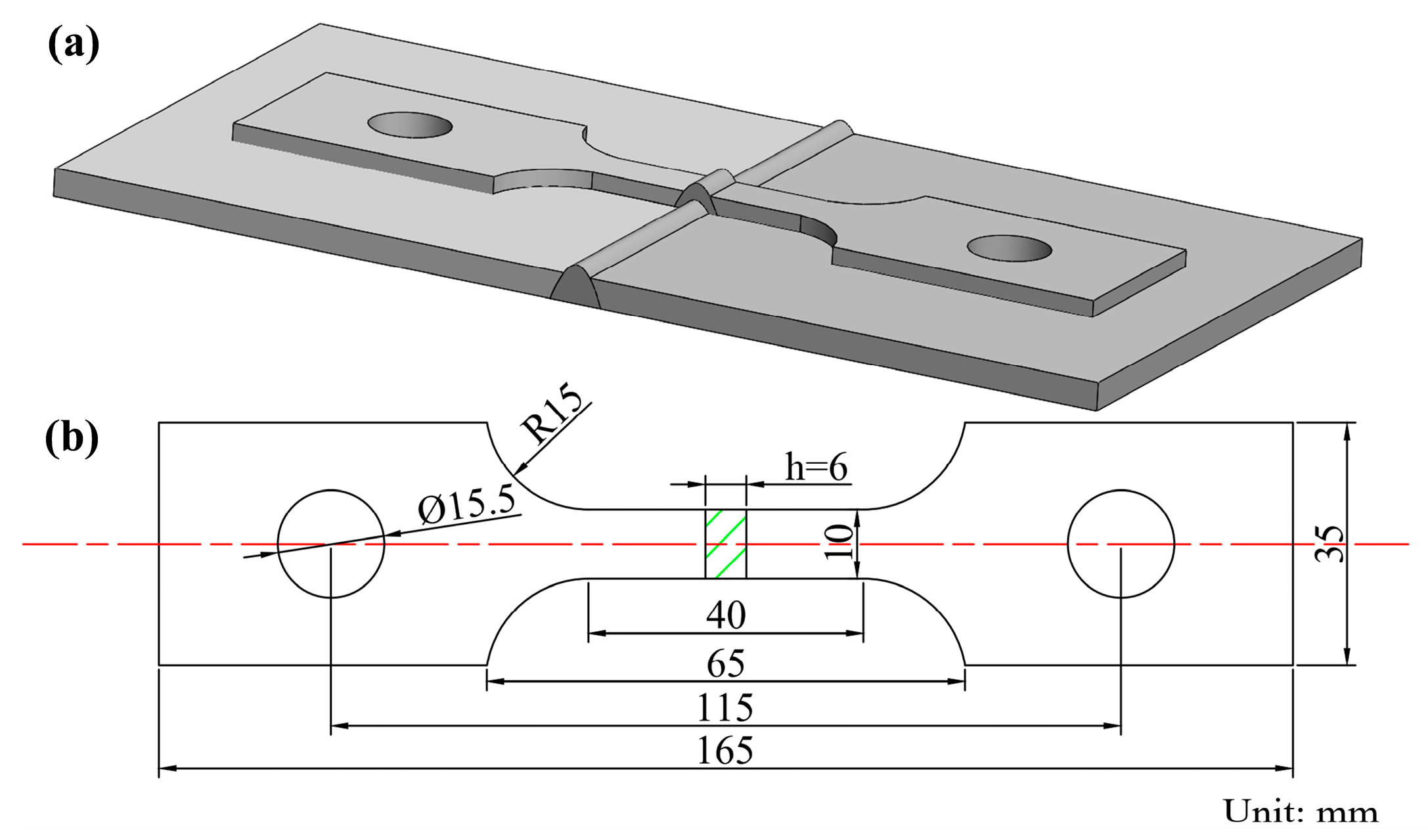


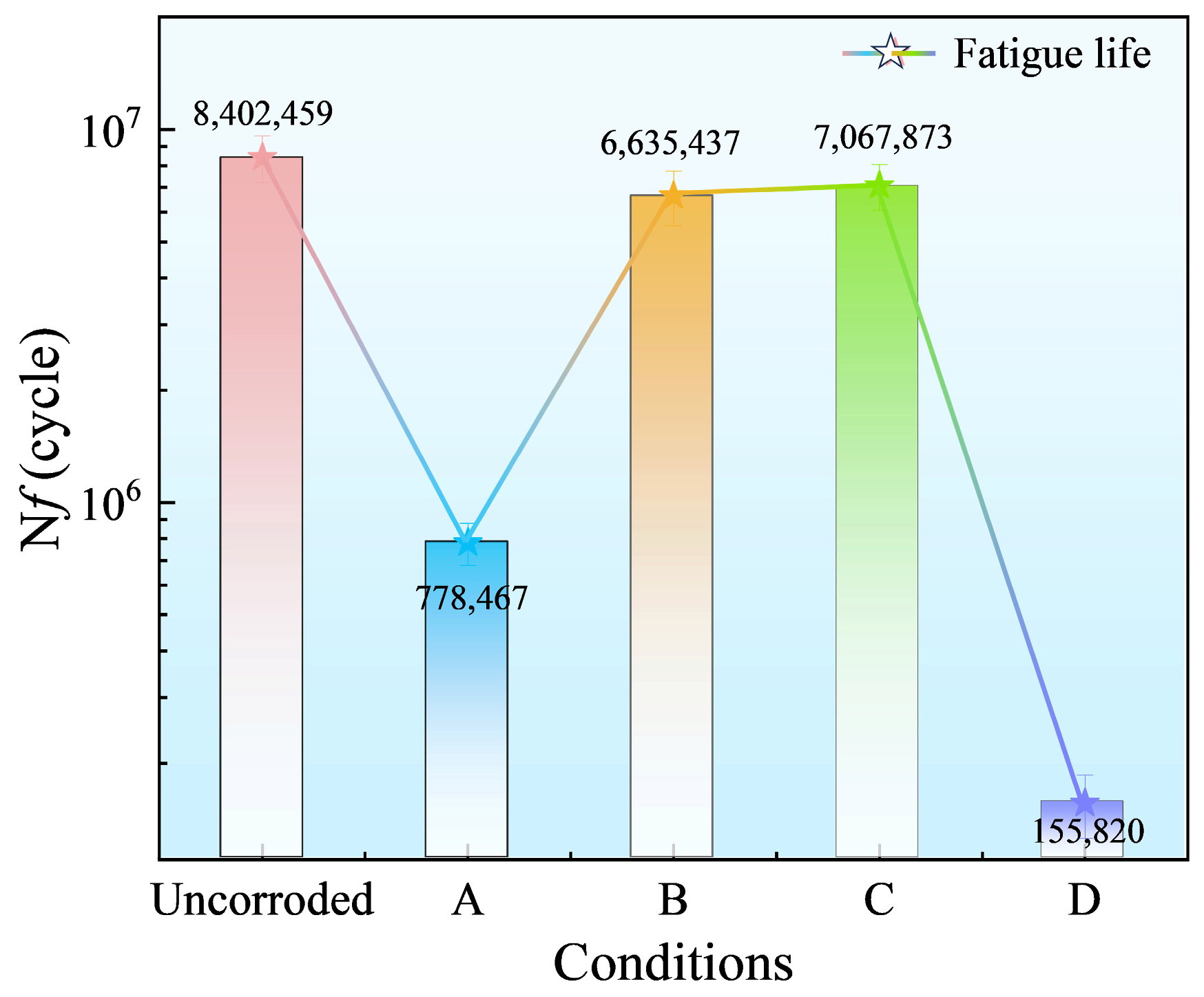


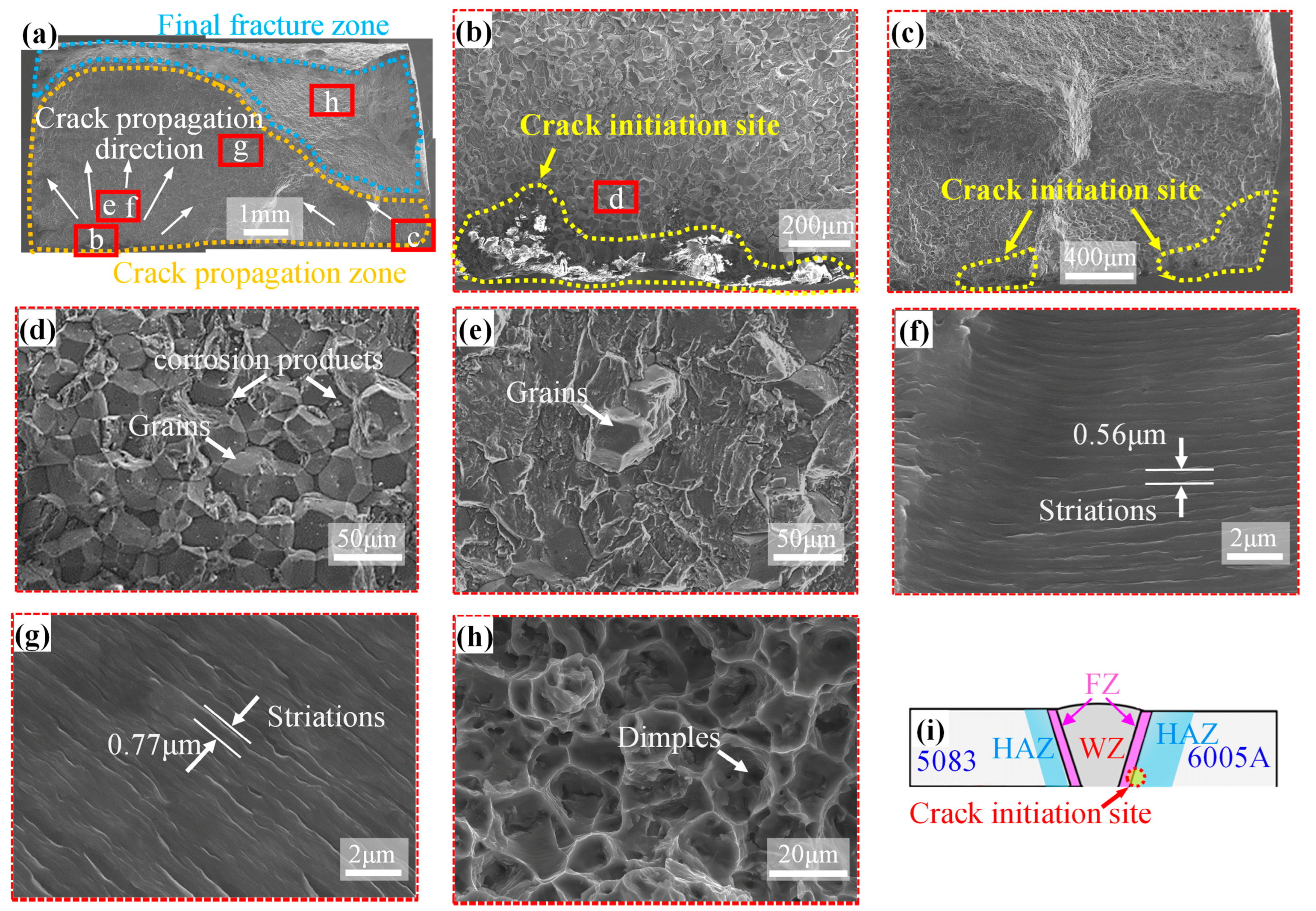

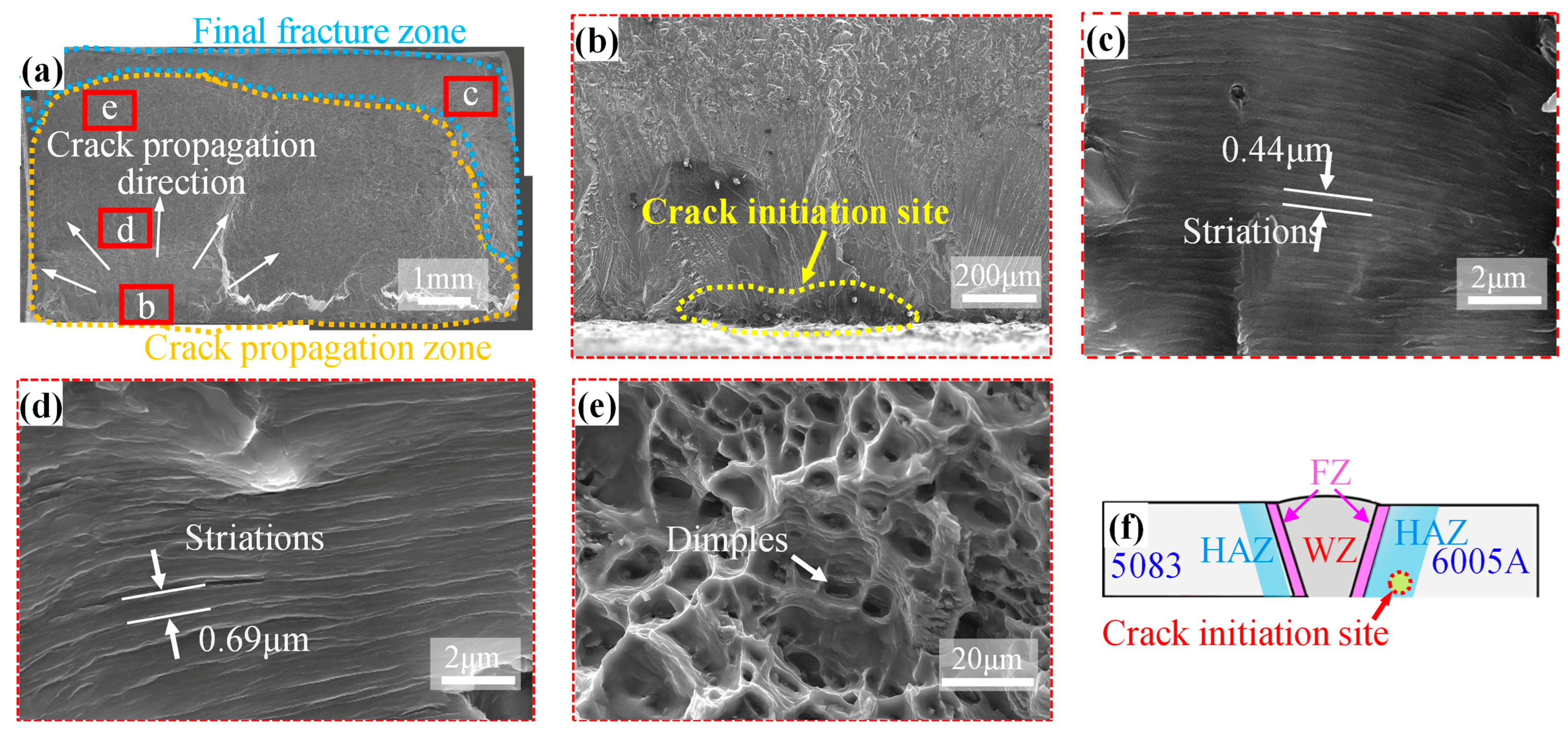
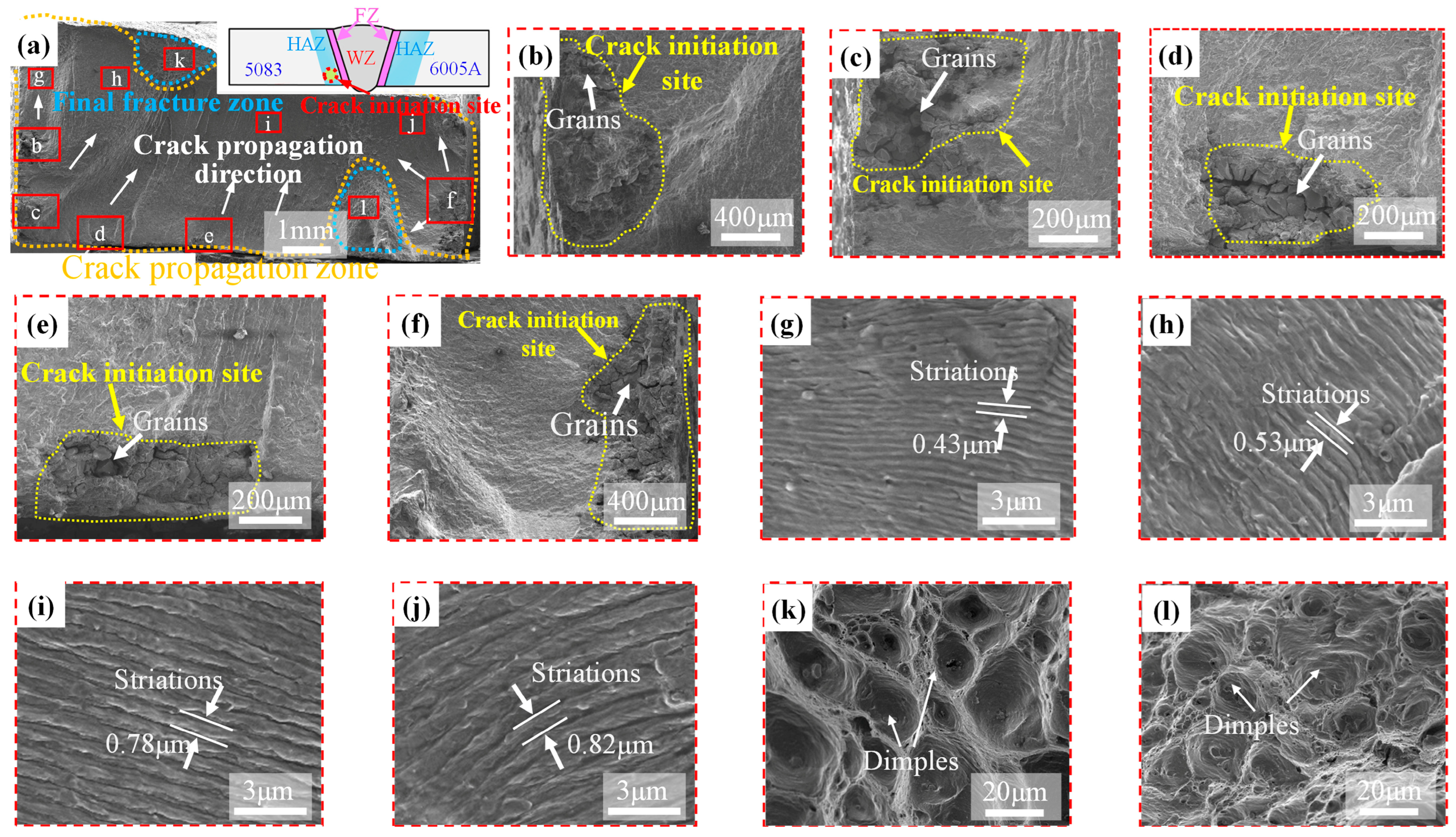
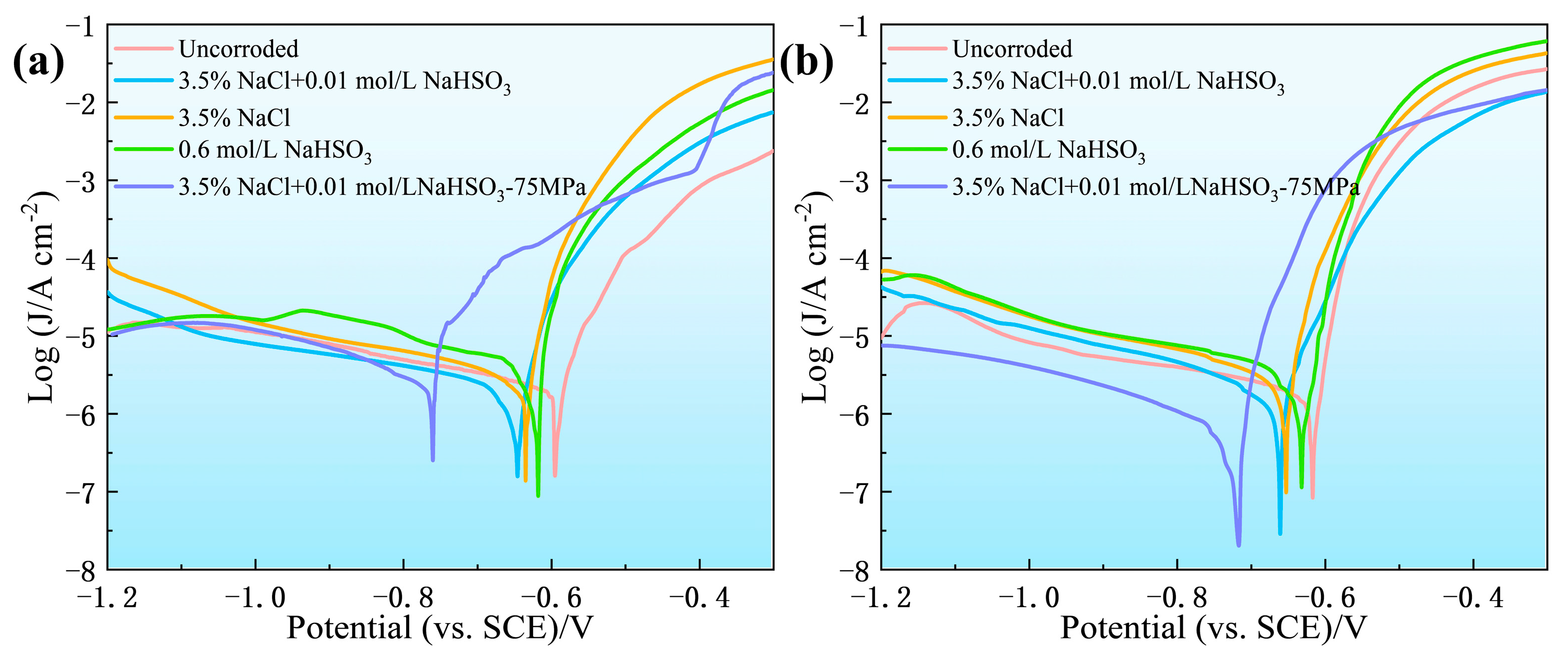

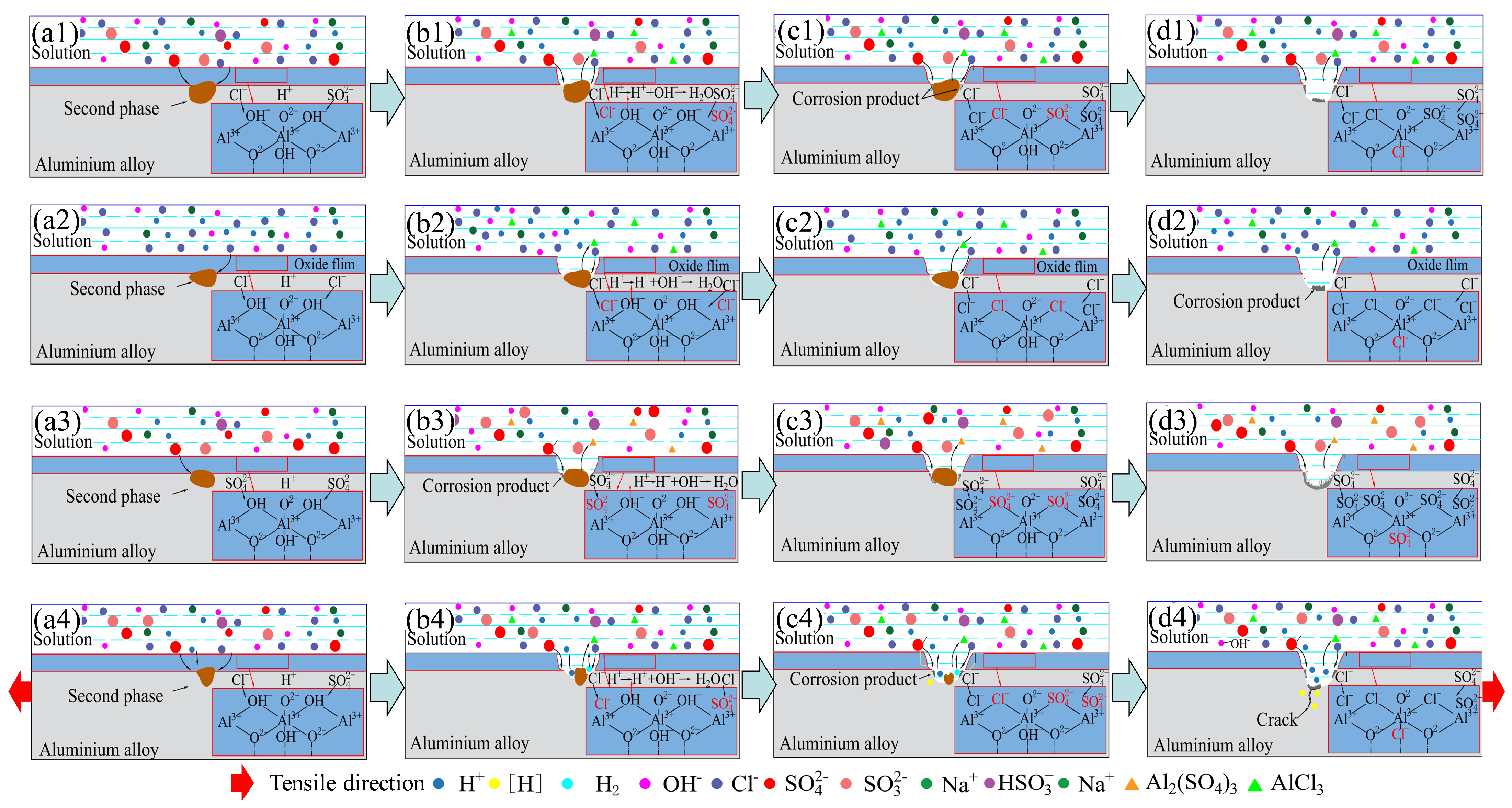
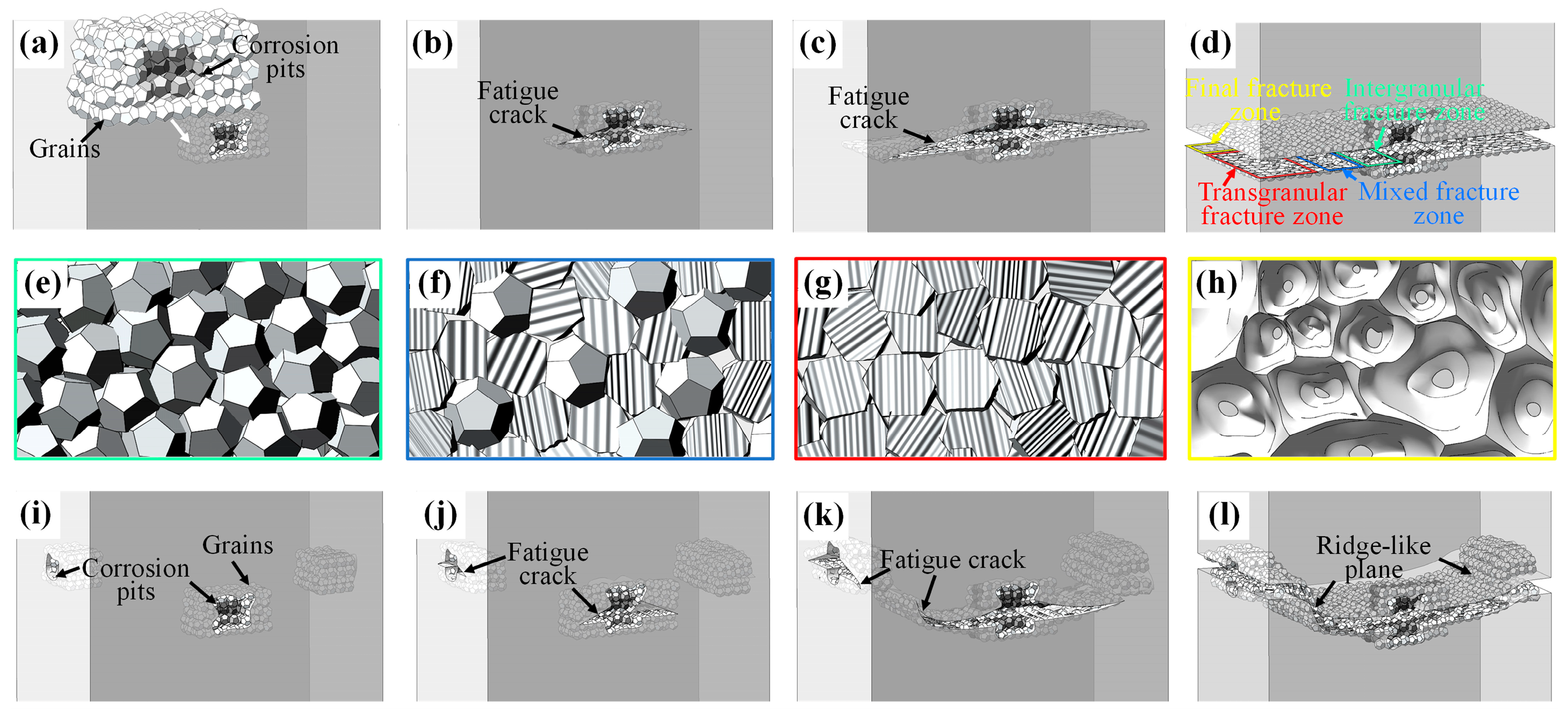
| Materials | Si | Fe | Cu | Mn | Mg | Zn | Cr | Ti | Al |
|---|---|---|---|---|---|---|---|---|---|
| 5083 | 0.09 | 0.20 | 0.01 | 0.75 | 4.98 | 0.02 | 0.09 | 0.05 | bal. |
| 6005A | 0.50 | 0.19 | 0.01 | 0.26 | 0.71 | 0.02 | 0.16 | 0.06 | bal. |
| ER5356 | 0.12 | 0.12 | 0.08 | 0.15 | 4.90 | 0.12 | 0.11 | 0.12 | bal. |
| Experimental Conditions | 5083 | 6005A | ||
|---|---|---|---|---|
| Ecorr (v. SCE)/(V) | Jcorr/(μA·cm−2) | Ecorr (v. SCE)/(V) | Jcorr/(μA·cm−2) | |
| Uncorroded | −0.594 | 2.00 | −0.617 | 1.95 |
| A condition | −0.650 | 4.01 | −0.663 | 2.50 |
| B condition | −0.631 | 4.50 | −0.654 | 2.32 |
| C condition | −0.621 | 6.17 | −0.633 | 4.27 |
| D condition | −0.762 | 2.23 | −0.723 | 0.81 |
Disclaimer/Publisher’s Note: The statements, opinions and data contained in all publications are solely those of the individual author(s) and contributor(s) and not of MDPI and/or the editor(s). MDPI and/or the editor(s) disclaim responsibility for any injury to people or property resulting from any ideas, methods, instructions or products referred to in the content. |
© 2024 by the authors. Licensee MDPI, Basel, Switzerland. This article is an open access article distributed under the terms and conditions of the Creative Commons Attribution (CC BY) license (https://creativecommons.org/licenses/by/4.0/).
Share and Cite
Wu, H.; Chen, Y.; Lu, D.; He, G. Effect of Corrosion Environment on Mechanical Behavior of 5083/6005A Welded Joints. Metals 2024, 14, 925. https://doi.org/10.3390/met14080925
Wu H, Chen Y, Lu D, He G. Effect of Corrosion Environment on Mechanical Behavior of 5083/6005A Welded Joints. Metals. 2024; 14(8):925. https://doi.org/10.3390/met14080925
Chicago/Turabian StyleWu, Hailiang, Yuqiang Chen, Dingding Lu, and Guanqiang He. 2024. "Effect of Corrosion Environment on Mechanical Behavior of 5083/6005A Welded Joints" Metals 14, no. 8: 925. https://doi.org/10.3390/met14080925





